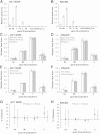Disialylated apolipoprotein C-III proteoform is associated with improved lipids in prediabetes and type 2 diabetes
- PMID: 26945091
- PMCID: PMC4847634
- DOI: 10.1194/jlr.P064816
Disialylated apolipoprotein C-III proteoform is associated with improved lipids in prediabetes and type 2 diabetes
Abstract
The apoC-III proteoform containing two sialic acid residues (apoC-III2) has different in vitro effects on lipid metabolism compared with asialylated (apoC-III0) or the most abundant monosialylated (apoC-III1) proteoforms. Cross-sectional and longitudinal associations between plasma apoC-III proteoforms (by mass spectrometric immunoassay) and plasma lipids were tested in two randomized clinical trials: ACT NOW, a study of pioglitazone in subjects with impaired glucose tolerance (n = 531), and RACED (n = 296), a study of intensive glycemic control and atherosclerosis in type 2 diabetes patients. At baseline, higher relative apoC-III2 and apoC-III2/apoC-III1 ratios were associated with lower triglycerides and total cholesterol in both cohorts, and with lower small dense LDL in the RACED. Longitudinally, changes in apoC-III2/apoC-III1 were inversely associated with changes in triglycerides in both cohorts, and with total and small dense LDL in the RACED. apoC-III2/apoC-III1 was also higher in patients treated with PPAR-γ agonists and was associated with reduced cardiovascular events in the RACED control group. Ex vivo studies of apoC-III complexes with higher apoC-III2/apoC-III1 showed attenuated inhibition of VLDL uptake by HepG2 cells and LPL-mediated lipolysis, providing possible functional explanations for the inverse association between a higher apoC-III2/apoC-III1 and hypertriglyceridemia, proatherogenic plasma lipid profiles, and cardiovascular risk.
Keywords: lipoproteins; mass spectrometry; proteomics; triglycerides; very low density lipoprotein.
Figures





References
-
- Ginsberg H. N., and Brown W. V.. 2011. Apolipoprotein CIII: 42 years old and even more interesting. Arterioscler. Thromb. Vasc. Biol. 31: 471–473. - PubMed
-
- Brown W. V., and Baginsky M. L.. 1972. Inhibition of lipoprotein lipase by an apoprotein of human very low density lipoprotein. Biochem. Biophys. Res. Commun. 46: 375–382. - PubMed
-
- Windler E., and Havel R. J.. 1985. Inhibitory effects of C apolipoproteins from rats and humans on the uptake of triglyceride-rich lipoproteins and their remnants by the perfused rat liver. J. Lipid Res. 26: 556–565. - PubMed
MeSH terms
Substances
Grants and funding
LinkOut - more resources
Full Text Sources
Other Literature Sources
Medical

